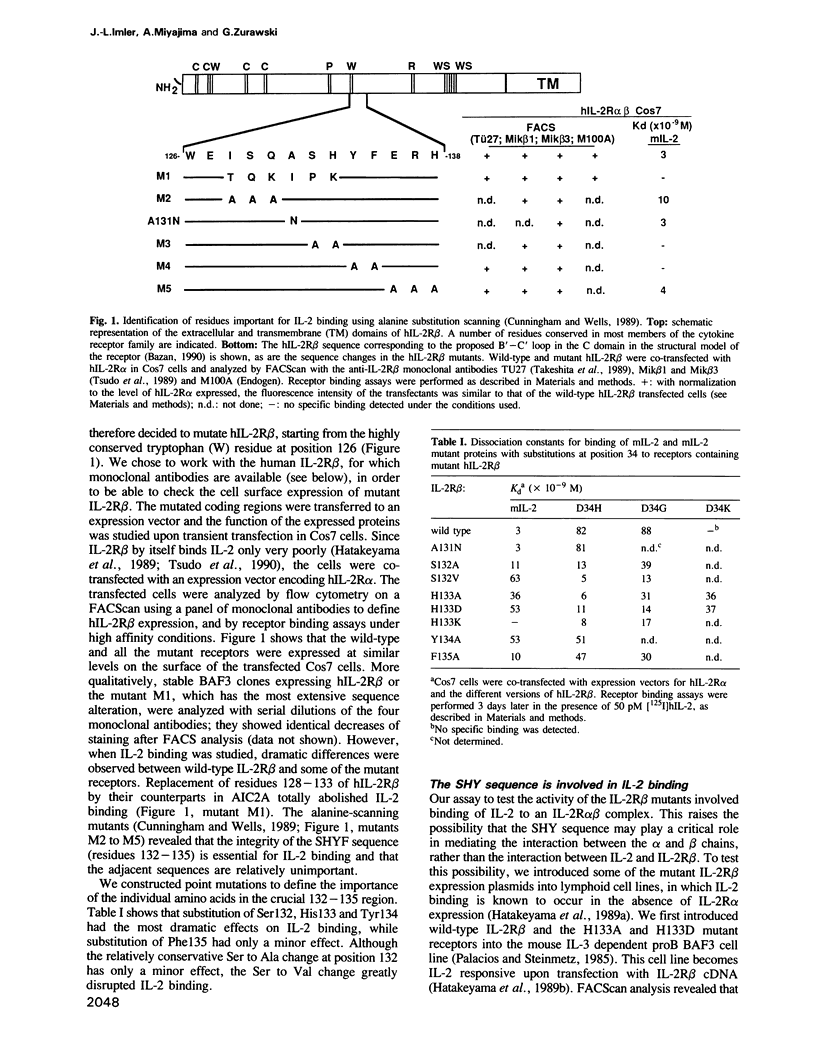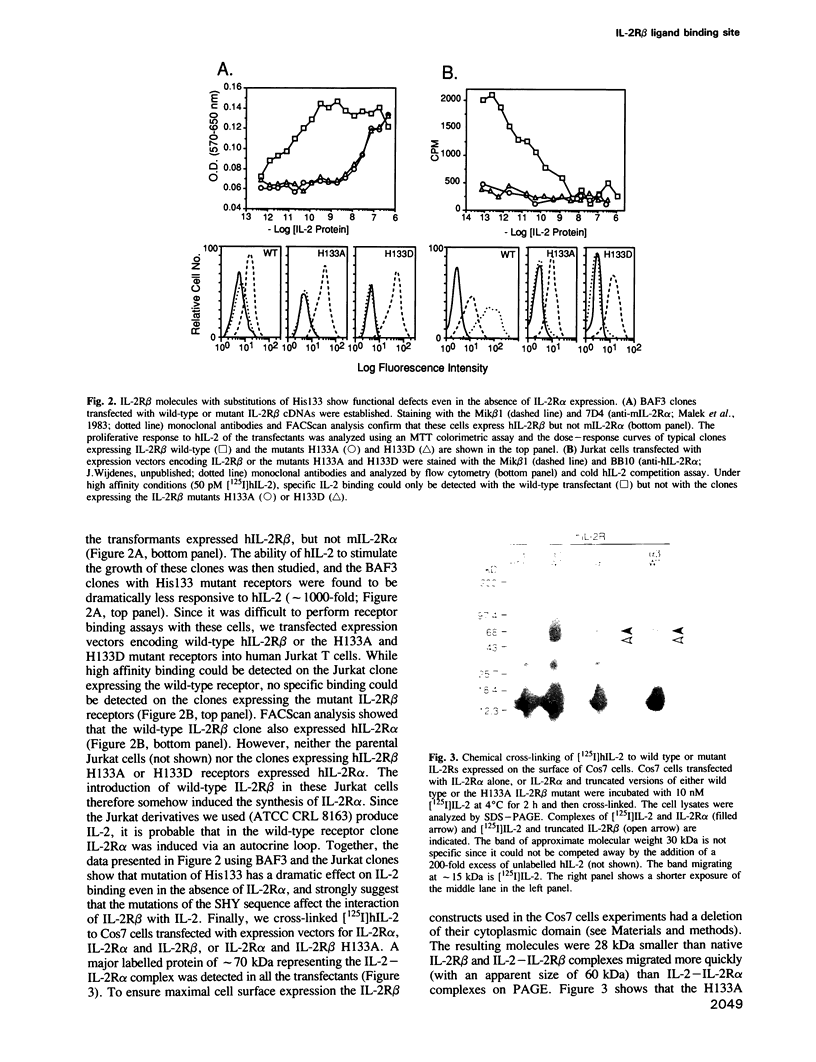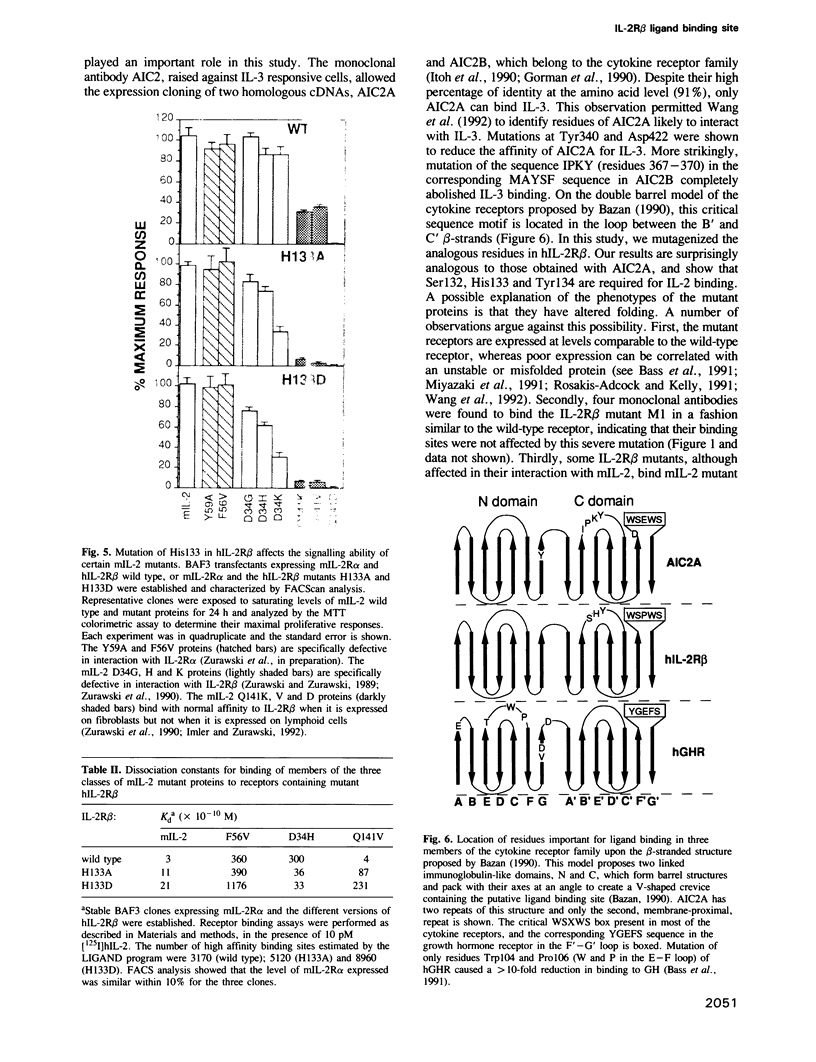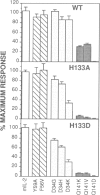Abstract
The beta chain of the interleukin-2 (IL-2) receptor (IL-2R beta) and the interleukin-3 (IL-3) binding protein AIC2A are members of the family of cytokine receptors, which also includes the receptors for growth hormone (GHR) and prolactin. A four amino acid sequence of AIC2A has recently been shown to be critical for IL-3 binding. We analyze here the function of the analogous sequence of human IL-2R beta and identify three amino acids, Ser132, His133 and Tyr134, which play a critical role in IL-2 binding. We show that some mutant IL-2 proteins with substitutions of a critical Asp residue in the N-terminal alpha-helix bind the mutant IL-2R beta receptor with a higher affinity than the wild-type receptor. This suggests that the critical Asp34 in the ligand and the sequence Ser-His-Tyr (positions 132-134) in the receptor interact directly. On the double barrel beta-stranded structural model of cytokine receptors, the residues important for ligand binding in IL-2R beta, AIC2A and GHR map to strikingly similar locations within a barrel, with the interesting difference that it is the N-terminal barrel for GHR and the C-terminal barrel for IL-2R beta and AIC2A.
Full text
PDF






Images in this article
Selected References
These references are in PubMed. This may not be the complete list of references from this article.
- Bass S. H., Mulkerrin M. G., Wells J. A. A systematic mutational analysis of hormone-binding determinants in the human growth hormone receptor. Proc Natl Acad Sci U S A. 1991 May 15;88(10):4498–4502. doi: 10.1073/pnas.88.10.4498. [DOI] [PMC free article] [PubMed] [Google Scholar]
- Bazan J. F. Structural design and molecular evolution of a cytokine receptor superfamily. Proc Natl Acad Sci U S A. 1990 Sep;87(18):6934–6938. doi: 10.1073/pnas.87.18.6934. [DOI] [PMC free article] [PubMed] [Google Scholar]
- Collins L., Tsien W. H., Seals C., Hakimi J., Weber D., Bailon P., Hoskings J., Greene W. C., Toome V., Ju G. Identification of specific residues of human interleukin 2 that affect binding to the 70-kDa subunit (p70) of the interleukin 2 receptor. Proc Natl Acad Sci U S A. 1988 Oct;85(20):7709–7713. doi: 10.1073/pnas.85.20.7709. [DOI] [PMC free article] [PubMed] [Google Scholar]
- Collins M. K., Malde P., Miyajima A., Arai K., Smith K. A., Mulligan R. C. Evidence that the level of the p55 component of the interleukin (IL) 2 receptor can control IL 2 responsiveness in a murine IL 3-dependent cell. Eur J Immunol. 1990 Mar;20(3):573–578. doi: 10.1002/eji.1830200317. [DOI] [PubMed] [Google Scholar]
- Cosman D., Lyman S. D., Idzerda R. L., Beckmann M. P., Park L. S., Goodwin R. G., March C. J. A new cytokine receptor superfamily. Trends Biochem Sci. 1990 Jul;15(7):265–270. doi: 10.1016/0968-0004(90)90051-c. [DOI] [PubMed] [Google Scholar]
- Cunningham B. C., Wells J. A. High-resolution epitope mapping of hGH-receptor interactions by alanine-scanning mutagenesis. Science. 1989 Jun 2;244(4908):1081–1085. doi: 10.1126/science.2471267. [DOI] [PubMed] [Google Scholar]
- Devos R., Plaetinck G., Van der Heyden J., Cornelis S., Vandekerckhove J., Fiers W., Tavernier J. Molecular basis of a high affinity murine interleukin-5 receptor. EMBO J. 1991 Aug;10(8):2133–2137. doi: 10.1002/j.1460-2075.1991.tb07747.x. [DOI] [PMC free article] [PubMed] [Google Scholar]
- Fukunaga R., Ishizaka-Ikeda E., Pan C. X., Seto Y., Nagata S. Functional domains of the granulocyte colony-stimulating factor receptor. EMBO J. 1991 Oct;10(10):2855–2865. doi: 10.1002/j.1460-2075.1991.tb07835.x. [DOI] [PMC free article] [PubMed] [Google Scholar]
- Gibbs C. S., Zoller M. J. Identification of electrostatic interactions that determine the phosphorylation site specificity of the cAMP-dependent protein kinase. Biochemistry. 1991 Jun 4;30(22):5329–5334. doi: 10.1021/bi00236a001. [DOI] [PubMed] [Google Scholar]
- Gorman D. M., Itoh N., Kitamura T., Schreurs J., Yonehara S., Yahara I., Arai K., Miyajima A. Cloning and expression of a gene encoding an interleukin 3 receptor-like protein: identification of another member of the cytokine receptor gene family. Proc Natl Acad Sci U S A. 1990 Jul;87(14):5459–5463. doi: 10.1073/pnas.87.14.5459. [DOI] [PMC free article] [PubMed] [Google Scholar]
- Hatakeyama M., Mori H., Doi T., Taniguchi T. A restricted cytoplasmic region of IL-2 receptor beta chain is essential for growth signal transduction but not for ligand binding and internalization. Cell. 1989 Dec 1;59(5):837–845. doi: 10.1016/0092-8674(89)90607-7. [DOI] [PubMed] [Google Scholar]
- Hatakeyama M., Tsudo M., Minamoto S., Kono T., Doi T., Miyata T., Miyasaka M., Taniguchi T. Interleukin-2 receptor beta chain gene: generation of three receptor forms by cloned human alpha and beta chain cDNA's. Science. 1989 May 5;244(4904):551–556. doi: 10.1126/science.2785715. [DOI] [PubMed] [Google Scholar]
- Itoh N., Yonehara S., Schreurs J., Gorman D. M., Maruyama K., Ishii A., Yahara I., Arai K., Miyajima A. Cloning of an interleukin-3 receptor gene: a member of a distinct receptor gene family. Science. 1990 Jan 19;247(4940):324–327. doi: 10.1126/science.2404337. [DOI] [PubMed] [Google Scholar]
- Kitamura T., Hayashida K., Sakamaki K., Yokota T., Arai K., Miyajima A. Reconstitution of functional receptors for human granulocyte/macrophage colony-stimulating factor (GM-CSF): evidence that the protein encoded by the AIC2B cDNA is a subunit of the murine GM-CSF receptor. Proc Natl Acad Sci U S A. 1991 Jun 15;88(12):5082–5086. doi: 10.1073/pnas.88.12.5082. [DOI] [PMC free article] [PubMed] [Google Scholar]
- Kunkel T. A., Roberts J. D., Zakour R. A. Rapid and efficient site-specific mutagenesis without phenotypic selection. Methods Enzymol. 1987;154:367–382. doi: 10.1016/0076-6879(87)54085-x. [DOI] [PubMed] [Google Scholar]
- Malek T. R., Robb R. J., Shevach E. M. Identification and initial characterization of a rat monoclonal antibody reactive with the murine interleukin 2 receptor-ligand complex. Proc Natl Acad Sci U S A. 1983 Sep;80(18):5694–5698. doi: 10.1073/pnas.80.18.5694. [DOI] [PMC free article] [PubMed] [Google Scholar]
- Minamoto S., Mori H., Hatakeyama M., Kono T., Doi T., Ide T., Uede T., Taniguchi T. Characterization of the heterodimeric complex of human IL-2 receptor alpha.beta chains reconstituted in a mouse fibroblast cell line, L929. J Immunol. 1990 Oct 1;145(7):2177–2182. [PubMed] [Google Scholar]
- Miyazaki T., Maruyama M., Yamada G., Hatakeyama M., Taniguchi T. The integrity of the conserved 'WS motif' common to IL-2 and other cytokine receptors is essential for ligand binding and signal transduction. EMBO J. 1991 Nov;10(11):3191–3197. doi: 10.1002/j.1460-2075.1991.tb04881.x. [DOI] [PMC free article] [PubMed] [Google Scholar]
- Munson P. J. LIGAND: a computerized analysis of ligand binding data. Methods Enzymol. 1983;92:543–576. doi: 10.1016/0076-6879(83)92044-x. [DOI] [PubMed] [Google Scholar]
- Okayama H., Berg P. A cDNA cloning vector that permits expression of cDNA inserts in mammalian cells. Mol Cell Biol. 1983 Feb;3(2):280–289. doi: 10.1128/mcb.3.2.280. [DOI] [PMC free article] [PubMed] [Google Scholar]
- Palacios R., Steinmetz M. Il-3-dependent mouse clones that express B-220 surface antigen, contain Ig genes in germ-line configuration, and generate B lymphocytes in vivo. Cell. 1985 Jul;41(3):727–734. doi: 10.1016/s0092-8674(85)80053-2. [DOI] [PubMed] [Google Scholar]
- Patthy L. Homology of a domain of the growth hormone/prolactin receptor family with type III modules of fibronectin. Cell. 1990 Apr 6;61(1):13–14. doi: 10.1016/0092-8674(90)90208-v. [DOI] [PubMed] [Google Scholar]
- Rozakis-Adcock M., Kelly P. A. Mutational analysis of the ligand-binding domain of the prolactin receptor. J Biol Chem. 1991 Sep 5;266(25):16472–16477. [PubMed] [Google Scholar]
- Saito Y., Tada H., Sabe H., Honjo T. Biochemical evidence for a third chain of the interleukin-2 receptor. J Biol Chem. 1991 Nov 25;266(33):22186–22191. [PubMed] [Google Scholar]
- Saragovi H., Malek T. R. Evidence for additional subunits associated to the mouse interleukin 2 receptor p55/p75 complex. Proc Natl Acad Sci U S A. 1990 Jan;87(1):11–15. doi: 10.1073/pnas.87.1.11. [DOI] [PMC free article] [PubMed] [Google Scholar]
- Sauvé K., Nachman M., Spence C., Bailon P., Campbell E., Tsien W. H., Kondas J. A., Hakimi J., Ju G. Localization in human interleukin 2 of the binding site to the alpha chain (p55) of the interleukin 2 receptor. Proc Natl Acad Sci U S A. 1991 Jun 1;88(11):4636–4640. doi: 10.1073/pnas.88.11.4636. [DOI] [PMC free article] [PubMed] [Google Scholar]
- Shanafelt A. B., Miyajima A., Kitamura T., Kastelein R. A. The amino-terminal helix of GM-CSF and IL-5 governs high affinity binding to their receptors. EMBO J. 1991 Dec;10(13):4105–4112. doi: 10.1002/j.1460-2075.1991.tb04987.x. [DOI] [PMC free article] [PubMed] [Google Scholar]
- Sharon M., Gnarra J. R., Leonard W. J. A 100-kilodalton protein is associated with the murine interleukin 2 receptor: biochemical evidence that p100 is distinct from the alpha and beta chains. Proc Natl Acad Sci U S A. 1990 Jun;87(12):4869–4873. doi: 10.1073/pnas.87.12.4869. [DOI] [PMC free article] [PubMed] [Google Scholar]
- Smith K. A. The interleukin 2 receptor. Annu Rev Cell Biol. 1989;5:397–425. doi: 10.1146/annurev.cb.05.110189.002145. [DOI] [PubMed] [Google Scholar]
- Strader C. D., Candelore M. R., Hill W. S., Sigal I. S., Dixon R. A. Identification of two serine residues involved in agonist activation of the beta-adrenergic receptor. J Biol Chem. 1989 Aug 15;264(23):13572–13578. [PubMed] [Google Scholar]
- Takeshita T., Goto Y., Tada K., Nagata K., Asao H., Sugamura K. Monoclonal antibody defining a molecule possibly identical to the p75 subunit of interleukin 2 receptor. J Exp Med. 1989 Apr 1;169(4):1323–1332. doi: 10.1084/jem.169.4.1323. [DOI] [PMC free article] [PubMed] [Google Scholar]
- Tsudo M., Karasuyama H., Kitamura F., Tanaka T., Kubo S., Yamamura Y., Tamatani T., Hatakeyama M., Taniguchi T., Miyasaka M. The IL-2 receptor beta-chain (p70). Ligand binding ability of the cDNA-encoding membrane and secreted forms. J Immunol. 1990 Jul 15;145(2):599–606. [PubMed] [Google Scholar]
- Tsudo M., Kitamura F., Miyasaka M. Characterization of the interleukin 2 receptor beta chain using three distinct monoclonal antibodies. Proc Natl Acad Sci U S A. 1989 Mar;86(6):1982–1986. doi: 10.1073/pnas.86.6.1982. [DOI] [PMC free article] [PubMed] [Google Scholar]
- Waldmann T. A. The interleukin-2 receptor. J Biol Chem. 1991 Feb 15;266(5):2681–2684. [PubMed] [Google Scholar]
- Wang H. M., Ogorochi T., Arai K., Miyajima A. Structure of mouse interleukin 3 (IL-3) binding protein (AIC2A). Amino acid residues critical for IL-3 binding. J Biol Chem. 1992 Jan 15;267(2):979–983. [PubMed] [Google Scholar]
- Zurawski S. M., Imler J. L., Zurawski G. Partial agonist/antagonist mouse interleukin-2 proteins indicate that a third component of the receptor complex functions in signal transduction. EMBO J. 1990 Dec;9(12):3899–3905. doi: 10.1002/j.1460-2075.1990.tb07610.x. [DOI] [PMC free article] [PubMed] [Google Scholar]
- Zurawski S. M., Zurawski G. Mouse interleukin-2 structure-function studies: substitutions in the first alpha-helix can specifically inactivate p70 receptor binding and mutations in the fifth alpha-helix can specifically inactivate p55 receptor binding. EMBO J. 1989 Sep;8(9):2583–2590. doi: 10.1002/j.1460-2075.1989.tb08397.x. [DOI] [PMC free article] [PubMed] [Google Scholar]




